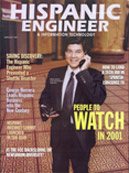As technology continues to dominate our businesses and lives, and the attention of some moves toward the "Digital Divide," an interesting yet common omission from the discussion is the need to ensure that young Latinas -- young girls -- are not left out of the efforts to gain access to technology for more Latinos.
In 1998, the AAUW Educational Foundation announced a 10-year research agenda focusing on girls' and young women's educational preparation for our increasingly technical, information-driven world. Their report, "Gender Gaps," revealed large disparities in girls' and boys' enrollments in advanced computing courses. Girls were less likely to take higher level computing classes in high school, although they outnumbered boys in word processing classes, today's version of typing.
When minority students were examined, the already sizable gaps grew even larger. For example, only 17 percent of students who took the Advanced Placement Computer Science tests in California in 1999 were girls. Looking at race/ethnicity, 65 percent of the test-takers were white, 22 percent Asian American, 5 percent African American, and 5 percent Hispanic (3 percent were "other"). The most disturbingly low numbers were those of Hispanic girls, especially when Hispanics' high overall representation in California's population is considered. In addition, 63 percent of Hispanic females scored 1 on the exam, compared with 41 percent of females as a whole who received this score. Students need to score a 3 or above to be eligible to receive college credit.
A commission was formed by the AAUW to examine this gender gap and discuss recommendations for research, practice, and policy to address it. The resulting report, out this year, is "Tech-Savvy: Educating Girls in the New Computer Age"
(http://www.aauw.org/2000/techsavvy.html)
While an emphasis was not put on race and ethnicity per se, many of the recommendations to engage girls in computing easily could be adapted and applied to a group of Hispanic girls or to any group of girls that includes Hispanics.
The report made several key observations:
* Girls are usually outnumbered in computer science classes and are at risk of social isolation, which makes learning difficult.
* Girls may worry that if they do well in computer science, their femininity or gender identity may be questioned.
* Girls and minorities who enroll in computer classes tend to come with fewer skills than their white male counterparts, who often have had much exposure to computers at home.
Among the report's key recommendations were to redesign computer science courses for equity and better instruction and make them more equitable and engaging to a broader audience of learners by:
* Integrating computer science throughout the curriculum. Show how computer science can be used to solve real-life problems.
* Teaching "tinkering" activities. Promote the exploration of machines, especially for middle-school girls, and create a social environment to encourage girls to "get under the hood."
* Striving for a critical mass of girls in classes. This might mean special recruiting and should also include attention to the ethnicity mix (the latter being my opinion).
* Designing the introductory class as a "pump," not a "filter." A girl's initial exposure to computing should be designed to encourage her to continue to pursue it, not point out where she is lacking and leave her behind.
If we hope to see more women, especially more Latinas, at the forefront of technology invention and development, we need to look to our girls to make certain they have a positive experience with computing instruction and a fair chance at succeeding with technology both today and in the future.
Aliza Pilar Sherman is a freelance writer, online marketing expert, and passionate evangelist for the Internet, where she built three pioneering Web sites for women. She is the author of the book, "Cybergrrl: A Woman's Guide to the World Wide Web" and the upcoming book "Cybergrrl @ Work: Tips and Inspiration for the Professional You." Ms. Sherman was a commissioner for the American Association of University Women "Tech-Savvy" report.

